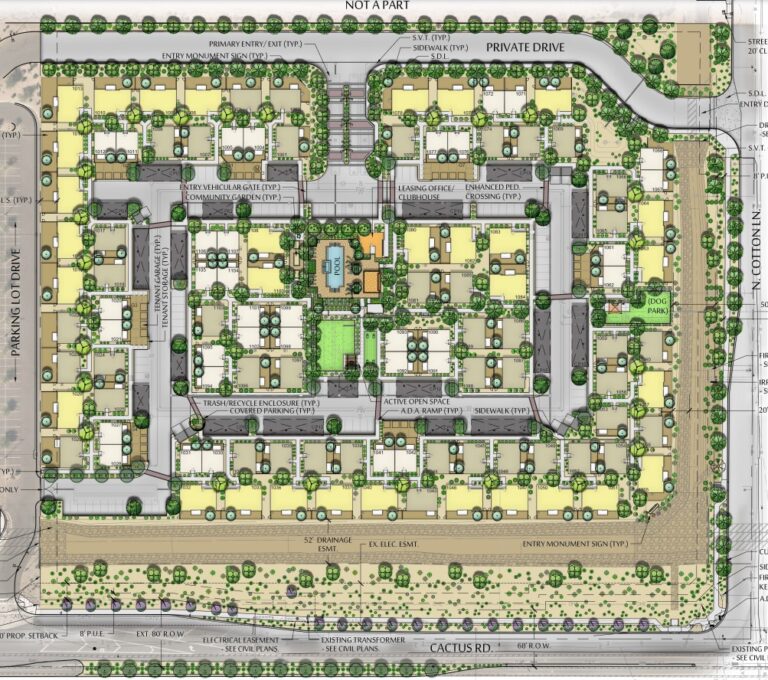By Roland Murphy for AZBEX
Earlier this month, the Surprise Planning and Zoning Commission voted to recommend a rezoning approval for an approximately 12.9-acre site at the NWC of Cotton Lane and Cactus Road. City Council followed the recommendation and approved the rezoning on June 20.
Developer NexMetro Communities requested the rezoning from Regional Commercial to High Density Residential so it can build Avilla Foothills, a 108-unit Build-to-Rent community.
NexMetro is a major regional and national developer in the Build-to-Rent sector. The DATABEX project database shows the company has completed eight projects under the Avilla brand and has another eight—not including Avilla Foothills—in various stages of development. Six of the eight yet-to-be delivered projects are listed as Under Construction.
The company website boasts a total of 50 Avilla Homes projects, and it has expanded into Dallas/Fort Worth, Austin, San Antonio, Denver, Tampa and Atlanta. In September 2020 NexMetro announced it had surpassed $1B in invested capital. In May of this year, it announced its invested capital had exceeded $2B.
Avilla Foothills
Avilla Foothills is planned for a mix of one-, two- and three-bedroom units. The one-bedroom units will be in attached duplex buildings, while the remaining units—which make up 69% of the total—will be detached. Units will range in size from 690SF to 1,265SF.
Planned amenities include a clubhouse/leasing office, a pool, active open space and a dog park.
The building and yard placements are intended to interact with both the streetscape and adjacent developments by variations in the roof lines and orientations, which will provide “small-scale pedestrian corridors, amenities, landscape features and architectural detail,” according to the project narrative.
The narrative also says, “A unique feature of Avilla Foothills is that every residence includes a private, 6-foot masonry wall enclosing the rear yard that is nearly as wide as the residence itself, with a minimum depth of 8 feet. Residents are allowed to customize their yards upon approval by the property management company.”
The Arguments in Favor
Developers have come to expect challenges and opposition to requests to rezone commercially designated properties to multifamily uses, particularly in comparatively slower to develop cities like Peoria and Surprise. Municipalities are generally loath to give up the potential sales tax revenue from sites where commercial development is viable.
Surprise has also developed a reputation for entrenched and organized resident opposition to multifamily, particularly in the form of Voice of Surprise—a resident group that has been particularly active in opposing several proposed developments over the past couple of years.
NexMetro and project representative law firm Burch & Cracchiolo took pains to target and negate these points of opposition in their project narrative and in their presentations to the Commission and Council, as well as in their meetings and outreach efforts to the surrounding community.
They pointed out that although the location has been zoned commercial since 2010 it has not drawn developer interest because of existing physical constraints and limited street access and visibility. The developers also used a market study by Rounds Consulting Group to highlight the fact there is already approximately 15.7MSF of developable commercial land in Surprise and more than 72MSF of land within two miles of the site that is either vacant or underdeveloped, leading to the conclusion that changing these 12.9 acres would have no significant impact on the potential for commercial development in the city.
Of particular concern was the impacts a commercial development would have on student pickups and drop-offs at the adjacent K-8 Legacy Traditional School, given the necessary access points. The NexMetro proposal, it was argued, would be far less disruptive, particularly given the access and egress plan the developer has put in place to accommodate demand and mitigate impacts.
The argument next turned to housing affordability, supply, demand and Surprise’s projected rate of population growth. The Rounds’ study found that Surprise had a rate of population growth of 2.3% per year over the last 10 years but that over the next 10 years the growth is projected at 44.2%, adding approximately 58,300 residents, which will require approximately 21,700 new housing units. To meet that demand, residential permits will have to grow from the current annual rate of approximately 1,486 to approximately 2,170 over the next 10 years.
Surprise has a comparatively low degree of housing diversity compared with the rest of metro Phoenix. The study shows the city’s housing is made up of 87.6% single-family homes, compared to 70.4% for the overall metro. Its share of multifamily homes is just 7.2%, versus a metro rate of 23.1%.
Lastly, the development team held one in-person and one virtual meeting to explain the proposal to interested neighbors. Neighbor concerns included worries about traffic impacts and available infrastructure, but they generally favored the single-story Build-to-Rent approach for the site, according to the staff report.
The developers also attended a virtual Voice of Surprise meeting to present the proposal. No statements of opposition were included in the staff materials presented to the Commission.
The point-by-point dismantling of opposition arguments in advance of the hearings proved effective. Several commissioners and Council members noted their general reticence to rezoning commercially designated properties but expressed the view that the change was warranted in this particular instance, as a Build-to-Rent community would prove to be a better use.
NexMetro Communities (NexMetro Development LLC) is the developer. The landscape architect is McGough Adamson. Terrascape Consulting is the civil engineer, and the project is represented by Burch & Cracchiolo, P.A.


